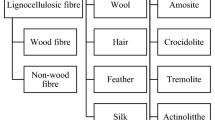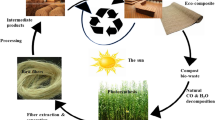Abstract
Plant-based composites (bio-composites) may in the future, become materials to replace polymer based composites and wood in terms of their attractive specific properties, lower cost, simple processing technologies, eco-friendliness, and ability to be recycled after use. The quality and performance of plant fibre-based composites can further be improved by adopting appropriate engineering techniques. Although plant-based fibres have these advantages, they also have some limitations. One of the serious problems of plant fibres is their strong polar character, which creates many problems of incompatibility with most thermosetting and thermoplastic matrices. Production of bio-composites with high quality and performance is therefore based on adjusting the properties of the constituents to meet the requirements of the composite material i.e. a product with consistent, uniform, predictable, and reproducible properties. Such adjustments involve creating strong interfacial bonds between the lignocellulosic substrates and the binder. Successful development of bio-composites therefore stem from a careful understanding of the influence of these adjustments on the composite properties. This paper suggests some opportunities available in producing bio-composites from non-wood resources, and the challenges that must be overcome to make this technology commercially viable. Gaps in knowledge and information required before full commercialisation of these materials are identified.

Similar content being viewed by others
References
Kandachar PV (2000) In: Proceedings of the International Workshop on the Development of natural Polymers and Composites in East Africa, Arusha Tanzania, September 2000, ICS-UNIDO pp 187–202
Rowell RM, Han JS, Rowell JS (2000) Natural polymers and agrofibres composites. San Carlos, Brazil, pp 115–134
Rowell RM (1983) Commonw Forest Bureau Oxford England 6(12):363
Bisanda ETN, Ansell MP (1992) J Mater Sci 27:1690
Ogola WO, Bisanda ETN, Tesha JV (2000) In: Proceedings of the 4th European Panel Products Symposium, Llandudno, Wales, UK, 11–13 October 2000, University of Wales, pp 175–185
Bolton AJ (1995) Outlook Agr 24(2):85
Zafeiropoulos NE, Williams DR, Baillie CA, Matthews FL (2002) Appl Sci Manuf 33(8):1083
Bisanda ETN, Ansell MP (1991) J Compos Sci Technol 41:164
Dinwoodie JM (1997) In: Proceedings of the 1st European Panel Products Symposium, Llandudno, Wales, 9–10 October 1997, University of Wales, pp 1–9
Nishimula T, Amin J, Ansell M (2001) In: Proceedings of the 5th European Panel Products Symposium, Llandudno, Wales, Oct. 2001, University of Wales, pp 155–166
English BP, Chow P, Bajwa DS (1996) In: Roger M, Raymond A, Young, Judith K Rowell (eds) Paper and composites from agro-based resources. Lewis Publishers, NY, pp 269–299
Ndazi B (2001) M.Sc. Thesis, University of Dar es Salaam
Vasishth RC (1971) In: Interregional Seminar on Industrial Processing of Rice, UNIDO Document. ID/WG/89/23 Joint UNIDO, FAO/ECAFE
Vasishth RC (1974) In: Assignee: Cor Tech Research Ltd. Patent, P.N. US 3850677, I.D.: 741126
Houwink R, Salomon G (1965) Adhesion and adhesives, 2nd edn., vol 1, chapter 1. Elsevier Publishing Company
Gerardi V, Minellin F, Viggiano D (1998) Biomass Bioenerg 4(3):295
Ono HK, Inoue A (1994) In: Hse CY, Tomita B, Branham SJ (eds) Adhesives and bonded wood products. Forest Products Society Proceedings, No. 4735 pp 330–343
Bolton J (1997) In: The Burgess-Lane Memorial Lectureship in Forestry, March 5, 1997. www.forestry.ubc.ca/burgess/bolton.html
Ferri U (2000) In: Proceedings of the International Workshop on the Development of natural Polymers and Composites in East Africa, Arusha Tanzania, Sept. 2000, ICS-UNIDO, pp 43–61
Bisanda ETN, Ogola W, Tesha JV (2003) Cement Concrete Comp 25(6):593
Bisanda ETN (2001) J Appl Comp Mater 7:331
Dunky M (2000) In: Proceedings of the 4th European Panel Products Symposium. Llandudno, Wales, Oct. 2000, University of Wales, Bangor, pp 1–14
Rowell RM (1995) In: Proceedings of a Seminar on Research in Industrial Application of Nonfood Crops, I: plant fibers, May 1995, Copenhagen, Denmark. Denmark Academy of Technical Series, pp 49–70
Acknowledgement
The authors wish to acknowledge the financial support from SIDA-SAREC, which has been sponsoring this project at the University of Dar es Salaam, Tanzania.
Author information
Authors and Affiliations
Corresponding author
Rights and permissions
About this article
Cite this article
Ndazi, B., Tesha, J.V. & Bisanda, E.T.N. Some opportunities and challenges of producing bio-composites from non-wood residues. J Mater Sci 41, 6984–6990 (2006). https://doi.org/10.1007/s10853-006-0216-3
Received:
Accepted:
Published:
Issue Date:
DOI: https://doi.org/10.1007/s10853-006-0216-3




